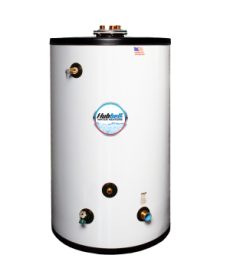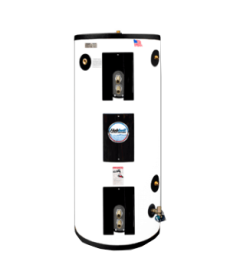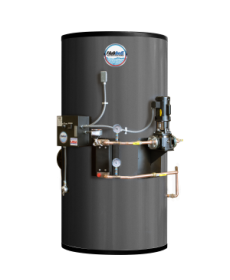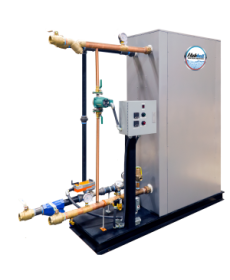
ASME Packaged Indirect Fired Water Heater
Hubbell Synergy Hydro BW
Storage Type
Vertical or Horizontal
80 - 5000 Gallon Capacity

Description
A Heavy Duty Indirect Fired Water Heater
The Synergy Hydro BW is a fully packaged indirect-fired water heater that utilizes boiler water or high-temperature hot water (HTHW) as the energy source for heating potable water. The entire package is designed to be a reliable and long-lasting source for hot water. Each component is carefully selected to ensure high performance in even the most demanding application. Whether you are heating potable water in a commercial building or process water in an industrial application, you can select a Hubbell Synergy Hydro BW to do the job.
Features
HydraStone™ cement lining provides superior protection and tank longevity
Heavy duty high-grade construction withstands demanding commercial/industrial use
- Factory selected and sized boiler water control valve simplifies installation and ensures reliable operation
- Full range of styles, sizes, and optional features to meet your exact heating needs
- Equipped with all operating controls and ready for immediate installation
Applications
Schools, office buildings, sports venues, hotels, industrial facilities, nursing homes, hospitals, and more.





FAQs
What temperature should I set my water heater?
For typical domestic potable hot water service the temperature of your water heater at 125°F is sufficient. This prevents wasted energy (which means cost savings for you) and also decreases the possibility of scalding water burns. If you run out of hot water on this setting, increase the temperature by five degrees incrementally until your hot water needs are met. The goal is to have the temperature set just high enough to meet your needs but within safe operating parameters. Please note that a water heater in and of itself should not be relied upon as the ultimate temperature controlling source for the hot water delivered to your fixtures. Please consult local and state codes for installation of the proper and code approved (ASSE 1016, 1070, 1017) mixing devices to achieve the safe delivery of hot water to the fixtures. For a more complete information please download the whitepaper PDF titled "Understanding Potential Water Heater Scald Hazards" developed by ASSE at the following link ASSE Whitepaper
Is it OK to use softened water with my cement lined tank?
Yes it is OK. A water softener system will not affect the longevity or operation of a Hubbell cement lined water heater tank. A water softener is typically installed when a potable water system has hard water resulting in the need to soften the water. Unfortunately, the salt used in a water softener corrodes the anode rod and exposed steel surfaces of the water heater tank, rapidly causing a glass lined water heater to corrode and leak within a few years. This is an issue for a glass lined water heater due to its reliance on a sacrificial anode, however because a cement lined tank does not use a sacrificial anode softened water is of no concern to the Hubbell cement lined tank.
What is a sacrificial anode and does a cement lined tank need one?
All water heaters constructed using a steel tank requires a lining to protect the internal steel surfaces from corrosion. Certain linings (i.e. glass and epoxy), due to their nature, have unavoidable holes and imperfections resulting in exposure of the steel tank. As a result of this deficiency, the manufacturer will install an anode rod(s) in an attempt to delay corrosion of the steel tank. An anode rod is typically made of aluminum, magnesium or zinc, is a maintenance item that requires periodic inspection and replacement, and is often times the cause of a “rotten egg” odor to your hot water. Often referred to as a sacrificial anode rod because, over time, it slowly dissolves, sacrificing itself as it is attacked by aggressive substances in the water which would otherwise attack the steel tank through the pinholes and imperfections of the glass or epoxy lining. A cement lined steel tank on the other hand does not require an anode because of the thickness and guaranteed 100% coverage of the cement lining over all internal surfaces of the steel tank. This eliminates the need for an anode rod in a cement lined water heater, resulting in a significantly longer life compared to a glass or epoxy lined water heater. For a further discussion please click on the following link Cement Lining
What is the max water temperature setting?
The Hubbell cement lined tank is suitable for storing water up to 194°F. However, it should be noted that your water heater will likely require optional control accessories to achieve this temperature, but there is no concern regarding the ability of the lining to withstand this temperature. Additionally, there are numerous safety concerns that must be considered when storing water at elevated temperature, please consult factory.
Which is better for me, a tankless or storage type water heater?
It depends. A tankless water heater is sometimes referred to as a Point-of-Use (POU) or instantaneous water heater. Due to the relative small physical size of a tankless water heater compared to a storage tank water heater, a tankless option can be advantageous from a space saving perspective and can sometimes be installed closer to where you want hot water (hence the term POU). However, tankless heaters are not suited for many applications, so it is critical that before choosing to go tankless you have carefully considered all of the factors that sometimes make the tankless option more complicated and risky compared to a storage type water heater. In particular, you should understand the operational characteristics, maintenance requirements, reparability, and sometimes significant installation requirements of a tankless water heater before making a decision. Tankless units do not store heated water like a storage type water heater; they only heat water as there is demand and therefore must be sized to meet the maximum flow for the application. In some cases a tankless water heater may improve operating efficiency, but possibly at the expense of user comfort. Hubbell tankless water heaters are available inElectric Tankless or Gas Tankless.
Is there a cold water dip tube in the Hubbell tank?
Not exactly. The Hubbell cement lined tank includes a cold water diffuser integrated into the cold water connection which allows incoming cold water to be introduced into the tank in a controlled and non turbulent manner, thus avoiding premature mixing of cold water with the hot water in the tank. On Hubbell cement lined tanks the cold water inlet/diffuser is located on the side in the lower portion of the tank. Therefore, a Hubbell cement lined tank does not require a long dip tube extending all the way from the top to the bottom of the tank as is common in glass lined tanks.
How does my water heater ship?
All Hubbell storage type water heaters ship via common carrier and are classified by the Commodity Classification Standards Board under National Motor Freight Classification (NMFC) class 100. Each water heater is palletized and wood crated. All Hubbell tankless water heaters, when transported using common carrier, ship class 77.5. To provide the lowest transportation cost, in most cases the shipment is made on Hubbell’s account and the freight cost is added to the invoice, commonly referred to as “Pre pay and add”. For very large shipments, the most economical method (LTL or Dedicated Truck) for transporting the water heaters to the final destination will be analyzed by Hubbell's transportation department.
Why is Hydrastone Cement a better choice over glass lining?
Cement lining provides guaranteed 100% coverage with a minimum thickness of 0.5” over all internal tank surfaces. In comparison, glass lining is approximately 0.005” thick and includes imperfections, pinholes and variation in coverage thickness resulting in portions of unprotected steel tank exposed to corrosion. In an attempt to compensate, glass lined tanks include a sacrificial anode in an effort to slow down the corrosion of the tank. Cement lined tanks on the other hand do not require an anode due to the integrity of the lining. As such, a cement lined tank will far outlast a glass lined tank. For a more complete explanation of the benefits of the Hubbell cement lining please click on the following link Cement Lining
The heater will be installed in Canada, what is CRN?
All provinces of Canada have adopted the ASME Code and require vessels to be stamped with a provincial registration number in addition to the ASME symbol and National Board stamping. Before construction begins, one requirement has to be met in all provinces of Canada. We must submit blueprints and specification sheets in triplicate of all designs for approval and registration by the chief inspector of the province in which the vessel is to be used. After the chief inspector receives the drawings, they are checked by an engineer to determine their compliance with the Code and also with provincial regulations. A CRN number is assigned and must be stamped on the vessel in addition to the ASME symbol and National Board stamping. Once the design has been approved and registered, any number of vessels of that design can be built and used in the province where it was approved. This process is repeated for each province. The Canadian provinces also require their own manufacturer's affidavit form, with the registration number and the shop inspector's signature on the data sheets. Finally, when a vessel is delivered to a purchaser in Canada, an affidavit of manufacturer bearing registration number and the signature of the authorized shop inspector must be sent to the chief inspector of the province for which it is intended.
What is the delivery time?
In most cases the delivery time for a Hubbell water heater is approximately 10 weeks after release for production, but can be 16 weeks or more depending upon the particular requirements of your application. However, there are various sizes and configurations which Hubbell has in stock for “Quick Ship” (as early as next day t to 2 weeks) to accommodate situations that require shorter delivery. Please consult with your Hubbell Sales Engineer to discuss delivery times for your application.
Why is a cement lined tank a better choice than stainless steel tank?
In almost all cases, a cement lined steel tank is a more robust tank compared to stainless steel. The weakness of a stainless steel tank is in the materials susceptibility to SCC (Stress Corrosion Cracking) caused by chlorides, bromides, iodides and fluorides in the water. The combination of residual stresses from welding, roll forming and stamping, and the cyclic stress from operating in a hot water system are sources of tensile stress, that when above a certain threshold stress, will make a stainless steel water heater tank susceptible to stress corrosion cracking. Cement lined steel tanks are not susceptible to this condition, and therefore are more resistant to corrosion and withstand the pressure and temperature cyclical operation of a water heater.
What type and size relief valve should be installed on my equipment?
The type of relief valve to be installed depends on the intended purpose of the equipment (heater or storage vessel), the medium (steam, air/gas, or liquid), the design temperature of the medium, the vessel code of construction (ASME Section I, IV, or VIII), and local plumbing codes. Local plumbing code take precedence. For more information see the following PDF flowchart here. The sizing of a relief valve depends on the desired operating pressure (not to exceed the rated pressure of the vessel), the type of relief valve (applicable ASME Code compliance as determined above), the medium in the vessel, the required relieving capacity (based on heat input, mass flow rate, or volumetric flow rate), and the relief valve manufacturer's specifications. When supplied with the above information, Hubbell can recommend a manufacturer's model and size.
What hi-limit control is provided for an over-temperature condition?
Hubbell provides a solenoid safety system for over-temperature situations. An aquastat senses the over-temperature condition and trips a solenoid which shunts the steam supply to the water heater. For semi-instantaneous water heaters (STX and BWX models) Hubbell provides an additional solenoid (aptly named a double solenoid) system to shunt the steam from entering the heating coil and to dump over heated water in the vessel to drain. For storage water heaters (ST and BW models) Hubbell provides a single solenoid system to shunt the steam supply to the heating coil thus preventing further over heating. A storage tank water heater does not typically include a second soeloid to dump the over heated water to drain due to the large volume of water that would need to be drained which could potentially exceed the capacity of the local drain.
What is the R value of a Hubbell water heater?
Hubbell uses a blown-in polyurethane foam insulation for all cement lined water heaters and tanks up to 150 gallon capacity. This insulation has an R value of 7.2 per inch. Most Hubbell tanks have a minimum of 2 inches of insulation resulting in an R value of 14. Certain models are available either standard or as an option with 3 inch insulation and therefore have an R value of 21. Large storage water heater tanks over 150 gallon capacity and custom made stainless steel or alloy tanks have either 2" or 3" fiberglass insulation with an R value of 3.5 per inch.
Why Hubbell recommends 300 series versus duplex stainless steel?
While it is true that duplex stainless steel typically offers higher strength and resistance to Stress Corrosion Cracking (SCC) and chloride corrosion compared to austenitic (300 series) stainless steel, there are other factors that ultimately make it a less desirable choice compared to 300 series stainless steel. Duplex stainless steel makes up only 1% of the stainless steel market making it less readily available and higher cost especially in flanges, fittings and formed parts such as tank heads. While it is commonly stated that this added expense is offset by the ability to use material that is thinner due to the higher strength, this only applies to very large tanks where a reduction results in using a lower common plate thickness. As an example, a thickness reduction of 25% for a tank that is 3/16" thick in 300 series stainless steel still results in using the common 3/16" thick plate size in duplex stainless steel. The higher strength of duplex also has the negative result of decreased formability and machinability, adding cost to the fabrication and production process. In terms of welding, duplex stainless steel presents many problems in maintaining the proper two phase mixture which commonly leads to issues in the Heat Affected Zone (HAZ) such as loss of corrosion resistance, toughness, and post-weld cracking. This is true in all duplex stainless steel welding processes including TIG, MIG and Laser. By comparison the process of welding austenitic stainless steel is much more forgiving. The main weakness of austenitic stainless steel is its susceptibility to Stress Corrosion Cracking (SCC) and chloride corrosion. Three factors that all must all be present cause this type of corrosion: elevated heat, the presence of chlorides, and residual stresses. In water heaters elevated heat and the presence of chlorides cannot be controlled. However, post-weld heat treating in a vacuum furnace followed by cooling in an inert atmosphere relieves the residual stresses in austenitic stainless steel tanks and therefore eliminates the susceptibility to this corrosion. For this reason, this post-weld heat procedure is performed on all Hubbell stainless steel tanks. The heat treating process is highly controlled and verifiable, unlike the difficult to control process of welding duplex stainless steel. Therefore, Hubbell offers stainless steel tanks fabricated from the 300 series (typically Type 304L or 316L) only, as this is a far more proven and verifiable material and fabrication process which will result in longer tank life. Of course, an alternative option is to specify the Hubbell cement lined steel tank which also provides a considerably longer life and is a more economical solution compared to duplex stainless steel and 300 series stainless steel.
Do Hubbell water heaters qualify as Low Lead?
Yes, all Hubbell water heater models qualify as meeting the low lead requirements of the “Reduction of Lead in Drinking Water Act” amendment to the “Safe Drinking Water Act” (SDWA) Section 1417(d) effective as of January 4, 2014. Hubbell certifies that its water heaters meet the following requirements of the SDWA and therefore are qualified and certified as Low Lead : (a)Hubbell water heater do not contain more than 0.2 percent lead with respect to solder and flux (b)Hubbell water heaters do not contain more than a weighted average of 0.25 percent lead with respect to all wetted surfaces of the water heater
Can my cement lined tank be damaged during installation and handling?
Although we don’t advocate dropping our tanks sometimes stuff happens. The Hubbell Hydrastone cement lining is a minimum of 1/2"thick (100 times thicker than a glass lined tank) and is guaranteed to uniformly cover 100% of all internal tank surfaces. Basically the Hubbell cement lining is a tank within a tank and should have no problem withstanding the rigors of shipping and installation. Although not necessry, you can specify an optional hand hole on our smaller tanks (150 gallon and under) to provide a means for inspection and repair. Water heaters with tanks larger than 36" generally include a 12" x 16" manway. In both cases, a Hubbell tank properly maintained will last decades.
How do I prepare my water heater for long term storage?
The water heater must be stored in the orientation of intended use (vertical, horizontal). The recommended ambient air temperature range is between 50 and 105 degree F and not exceeding 65% Rh. Under no conditions should the unit be subject to freezing temperatures. The unit is intended to be stored indoors, protected from the elements. Desiccant material should be inserted into the electric control panel and heating element terminal house (if applicable). Prolonged storage will require periodic inspection of desiccant. For cement lined tanks only, place approximately 10 gallons of water in the tank before closing and sealing all openings to ensure a humid atmosphere for the lining is maintained. Cap and seal all openings and tank tappings and/or flanges. Provide the necessary protection to ensure the tank and all accessories are protected from physical contact that could result in damage. Shrink wrapping or other suitable protective plastic may be applied to the exterior. Start up and installation guidelines must be followed, with particular attention to testing of the electric heating element.
When is ASME code required?
Engineers and designers should consider all local codes when specifying approval requirements. For an in depth explanation, reference the National Board of Boiler and Pressure Vessel Inspectors Guide In general, water heater pressure vessels require ASME if the heat input exceeds 200,000 Btu/Hr (58.6kW) or if the storage capacity exceeds 120 gallons. Many water heater manufacturers choose to label and rate their tank 119 gallon to avoid any confusion. However, a tank rated at 120 gallons does not require ASME as code is only required for tanks that exceed 120.
Documents
Technical Documents
Warranty
The water heater manufacturer shall warranty all components against defects in workmanship and material for a period of one (1) year from date of start-up, and the pressure vessel for a full five (5) years Non Pro-Rated (Square Optional: Full ten (10) years Non Pro-Rated) from date of start-up, provided that the unit is started within three (3) months of date of shipment and installed and operated within the scope of the tank design and operating capability. Each water heater shall be shipped with a complete set of installation and operating instructions including a spare parts list and approved drawing.
Technical Support
Our Technical Support Reps are ready to assist you. Please contact us today.






